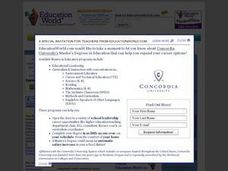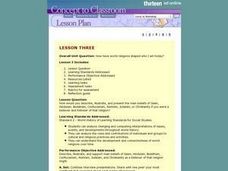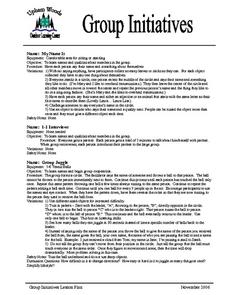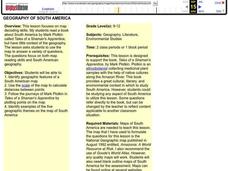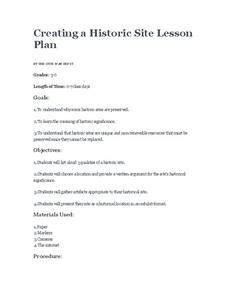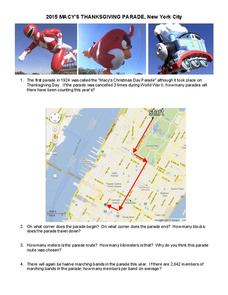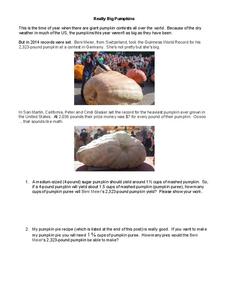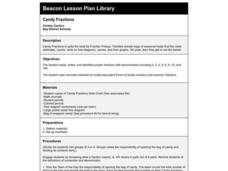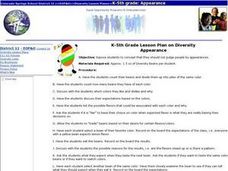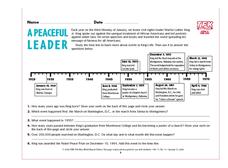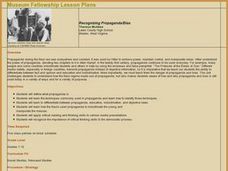Curated OER
Earth Day Number Sense
Elementary schoolers count and order objects using numbers 1-300. They bring recyclable items from home. Students group the items, skip count by 2's, 3's, and 5's, and arrange the items on a number line. Recyclable plastic bags are put...
Curated OER
"Eggs-ploring" Math with Jellybeans
Learners work in pairs with a small bag of jellybeans to estimate the number of candies in their bags and then figure out how many groups of 10 jellybeans are contained in their bags. They then graph the information using a pictograph or...
Indiana University
World Literature: "One Evening in the Rainy Season" Shi Zhecun
Did you know that modern Chinese literature “grew from the psychoanalytical theory of Sigmund Freud”? Designed for a world literature class, seniors are introduced to “One Evening in the Rainy Season,” Shi Zhecun’s stream of...
Curated OER
Lesson Three
Students describe, illustrate, and present main beliefs of Islam, Hinduism, Buddhism, Confucianism, Animism, Judaism, or Christianity religion. They share with a partner their most significant fact about each leader interviewed. Students...
Curated OER
China: Land Beyond the Wall
An excellent series of five lessons on China awaits you and your young geographers. In these lessons, learners engage in hands-on activities, watch streamed video, access websites, and complete activities in cooperative groups in order...
Curated OER
Show Me The Money
Third graders explore the value of U.S. money. In this money lesson, 3rd graders print out pictures of money from the Internet and create play money. The students will play a game in which they display the amount of money called out by...
Curated OER
It's On Sale
First graders read the book The Great Pet Sale to learn about economics and advertisements. In this economics lesson plan, 1st graders read the book The Great Pet Sale and define related vocabulary words. Students compare prices to find...
Curated OER
Group Initiatives
Students explore the names and qualities about members in the group. They each say their name and something about themselves. Students gather around in a circle. They listen to the teacher as he or she says the name of someone and throws...
Curated OER
Geography of South America
Student's identify geographic features of a South American map. They use the scale of the map to calculate distances between points. They identify examples of the five geographic themes on the map of South America.
Curated OER
Rainbow Fish: The Copycat Fish Lesson Plan
Students explore the concept of copying one another. For this early childhood lesson plan, students discuss what a copycat is and why people copy one another. Students then discuss the story Rainbow Fish: The Copycat Fish, recording...
Curated OER
Halloween How Many #2 (Word Names for Numbers)
For this math worksheet, students read the word names for the numbers one through five. Students draw a line from each number word to the group that shows how many. The pictures are Halloween related.
Civil War Trust
Creating a Historic Site
A historic site marks a place where a relevant historical event occurred, no matter how many people know about it. Small groups choose their own historical sites, including a place where a class member was born, or even a...
Yummy Math
2015 Macy's Thanksgiving Parade
Take a seat on the parade route with a holiday-themed set of word problems. Young mathematicians answer questions based on the annual Macy's Thanksgiving Parade in New York City, including finding the average number of members in a...
Yummy Math
Really Big Pumpkins
You may think your holiday pumpkins weigh a ton, but in a giant pumpkin contest, they actually do! Middle schoolers read about the winners of the 2014 giant pumpkin contests before solving three word problems involving multiplication and...
Read Works
Edison Tried and Tried Again
How many times did it take Thomas Edison to invent a successful working lightbulb? Young learners read a short passage about this famous inventor and his determination in getting an idea to work successfully. Then, pupils respond to four...
Curated OER
South African Trivia
In this South African Trivia worksheet, 6th graders research and answer questions about South Africa. Students write fifty-five answers.
Curated OER
Candy Fractions
Second graders complete math activities with donated seasonal treats. They estimate, count, sort, name and graph bags of treats. They can eat treats when finished.
Curated OER
The Rights of the Child
Learners create a set of rights that promote safety and tolerance at the school site. In this Bill of Rights lesson, students read the U.N. Declaration on Rights of the Child. Student presenters lead a discussion of these rights and have...
Curated OER
Three Branches of Government+++A Visual Representation
Third graders identify the three branches of government, describing their functions, and the important people in each branch. They construct models of the buildings and people to visually represent the Legislative, Executive, and...
Curated OER
Making Choices
Second graders explore financial decision making. In this introductory economics lesson, 2nd graders listen to the book Alexander, Who Used to be Rich Last Sunday by Judith Viorst, and discuss making financial choices based on wants and...
Curated OER
Diversity: Appearance
Students collect several 'diversity beans' and sort them into piles based on the color of the beans and if they believe they will enjoy the flavor concluded from the outside appearance. In this diversity lesson, students...
Curated OER
Fashion Capitols
Young scholars divide into groups to research one of the five major fashion capitols of the world. They share their research with other groups in order to answer worksheet questions.
Time For Kids
A Peaceful Leader
The legacy of Dr. Martin Luther King, Jr's life and message is just as important today as it was in his lifetime. Introduce elementary learners to the movement for civil rights with a timeline of Dr. King's life, as well as...
Curated OER
Recognizing Propaganda/Bias
Middle and high schoolers examine the uses of propaganda during the Nazi era. Using examples of propaganda used by Hitler, they discuss how it changed the thinking and ideas of people exposed to it. In groups, they identify how and why...

